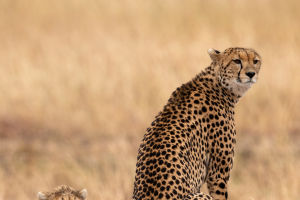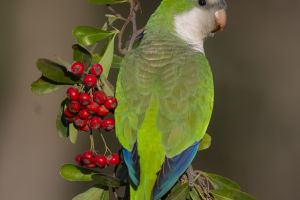
Squirrel

Baby squirrels are known for their iconic big, fluffy tails, which serve multiple purposes in their lives.
These bushy tails help them navigate their arboreal environment, ensuring their safety and comfort.
When a squirrel jumps from one tree to another, its big tail serves as a crucial tool for increasing its jumping distance. By straightening its tail, a squirrel can jump more than ten meters, allowing it to escape quickly when facing threats from predators or other dangers.
Moreover, the large tail acts like a parachute when the squirrel jumps down from a tree. It helps the squirrel descend safely to the ground by slowing down its fall and providing a cushioning effect upon landing. The fluffy, thick texture of the tail serves as a natural shock absorber, minimizing the impact on the squirrel's body.
Related
 The leopard is a feline that inhabits temperate, savannah, or semi-desert areas.
The leopard is a feline that inhabits temperate, savannah, or semi-desert areas.
 Gentoo Penguins are charming and fast but need conservation due to habitat threats.
Gentoo Penguins are charming and fast but need conservation due to habitat threats.
 The Majestic Humpback Whale: Guardians of the Deep.
The Majestic Humpback Whale: Guardians of the Deep.
 Discovering the brilliance of sea lion intelligence and behavior.
Discovering the brilliance of sea lion intelligence and behavior.
 Parrots: beloved for mimicry and vibrant plumage, they symbolize joy, facing threats but cherished as companions.
Parrots: beloved for mimicry and vibrant plumage, they symbolize joy, facing threats but cherished as companions.
 Not only does the starfish have a slightly fancy-sounding name, but it is also a very mysterious creature.
Not only does the starfish have a slightly fancy-sounding name, but it is also a very mysterious creature.
During rest periods, such as at night when the squirrel sleeps, it utilizes its tail for warmth and protection. By wrapping its tail around its body, the squirrel creates a cozy cocoon, shielding itself from the cold and providing insulation against the elements. In this way, the tail functions like a quilt, helping the squirrel maintain its body temperature and conserve energy while resting.
Squirrels are highly adaptable creatures, well-suited to their arboreal habitats. They are active and intelligent animals with large, bright eyes, enabling them to navigate their surroundings with ease.
Most squirrels inhabit cold temperate coniferous forests and mixed coniferous and broad-leaved forests, particularly in mountainous regions or wooded areas near river valleys. Here, they thrive in large numbers, exhibiting their characteristic agility and resourcefulness.
Unlike many other nocturnal animals, squirrels are diurnal, meaning they are active during the day and rest at night. They prefer solitary living arrangements, often building nests in trees where they can retreat for safety and shelter. In the mornings, squirrels are particularly lively, engaging in various activities such as foraging for food or engaging in playful behavior.
Squirrels demonstrate remarkable survival skills, especially in harsh weather conditions. During heavy snowfall or extreme cold, they seal their burrows with hay and rely on their fluffy tails for warmth.
By huddling inside their nests and wrapping their tails around their bodies, squirrels can endure prolonged periods without venturing outside. When temperatures rise, they emerge to search for food, which primarily consists of nuts such as acorns, chestnuts, and walnuts, as well as pine nuts and various vegetation.

In preparation for winter, squirrels diligently collect and store food supplies, often burying them in multiple locations for future consumption. Some species, like the flower mouse, possess cheek pouches that allow them to store large quantities of food for extended periods.
Additionally, squirrels may dry their food on trees to prevent spoilage and mold, ensuring a steady food source throughout the colder months.
Mother squirrels exhibit exceptional care for their young, constructing additional "rooms" within their nests for protection. They transfer their offspring to these safer locations if they detect any threats or dangers nearby. During migration to food-rich areas, mother squirrels carry their young with them, ensuring their survival and well-being.
In the natural world, every creature has evolved unique adaptations to ensure its survival and the squirrel is no exception. With its long, bushy tail, the squirrel can withstand the challenges of its environment, from cold winters to hot summers. Whether used for warmth, balance, or protection, the squirrel's tail remains a vital tool for its survival and well-being.